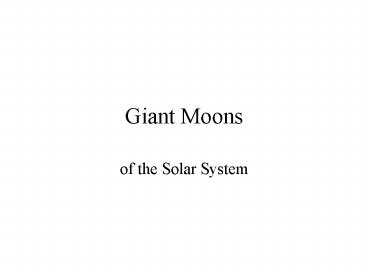Giant Moons - PowerPoint PPT Presentation
1 / 19
Title:
Giant Moons
Description:
of Jupiter, Io, Europa, Ganymede ... A close-up of Europa's icy crust. Ice rafts on Europa. The possible presence of a liquid water ocean under the icy crust of ... – PowerPoint PPT presentation
Number of Views:37
Avg rating:3.0/5.0
Title: Giant Moons
1
Giant Moons
- of the Solar System
2
Four of the largest moons in the solar system are
the Galilean moons of Jupiter, Io, Europa,
Ganymede and Callisto. Ganymede is the largest
moon in the solar system, and is actually bigger
than the planets Mercury and Pluto.
3
The Galilean Moons
Europa
Ganymede
Io
Callisto
4
Io is the most volcanically active body in the
solar- system. Its interior is molten, and
is warmed by tidal flexing due to the strong
gravitational tides raised on the moon by Jupiter.
5
Volcanic Activity on Io
6
More Views of Volcanic Activity on Io
Pictures taken by the Galileo Spacecraft.
7
Europa has an icy surface made of water ice.
There is evidence that there is an ocean
beneath the icy crust.
8
A close-up of Europas icy crust.
9
Ice rafts on Europa
10
The possible presence of a liquid water ocean
under the icy crust of Europa makes Europa a
prime site for life in the solar system.
Space Missions are currently on the drawing board
to send a spacecraft to
the surface of Europa, possibly to penetrate down
to the subsurface ocean.
11
Ganymede and Callisto also have icy crusts and
possibly oceans. Note the higher density of
craters on Callisto, indicating an older surface.
12
The largest moon orbiting Saturn is Titan. Titan
is distinguished by the fact that it is the only
moon in the solar system with an extensive
atmosphere. Here we see Titan as viewed by
the Voyager spacecraft. Surface details are
obscured by the
photochemical smog that forms in the atmosphere.
13
Images of the surface of Titan, obtained by the
Cassini spacecraft
Infrared
Radar
14
The Huygens probe on the Cassini spacecraft, now
orbiting Saturn, descended through the
atmosphere of Titan and achieved a soft landing
on its surface.
15
Descent photo from Huygens Probe
Photo from the surface of Titan
16
(No Transcript)
17
Methane lakes in the north polar region of Titan.
18
Extra Slides
19
These infrared views of Titan taken by HST show
surface features on Titan. The bright area may
be an ocean of methane. Methane plays the
same role on Titan as water does on earth. At
the frigid temperatures of Titan, Methane can
exist as a gas, liquid and solid, as water does
on earth

